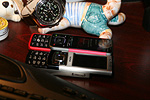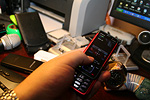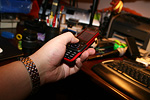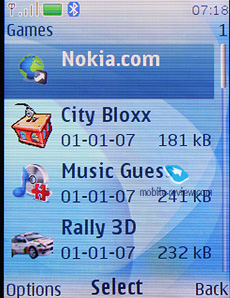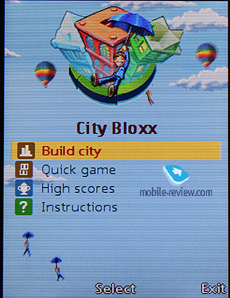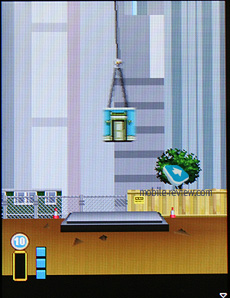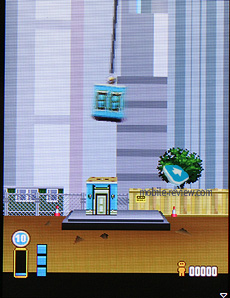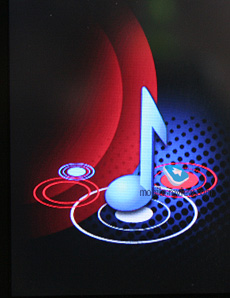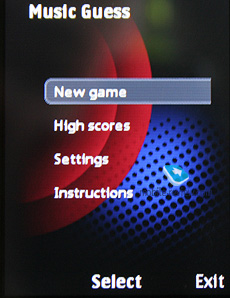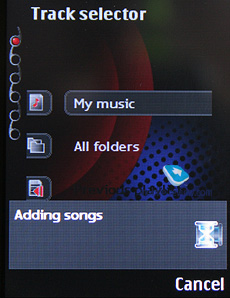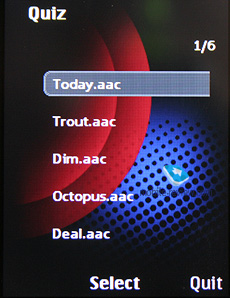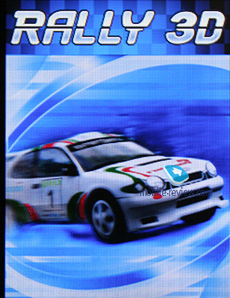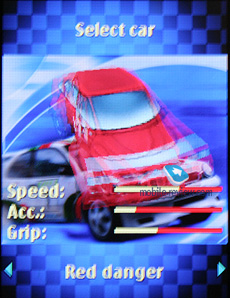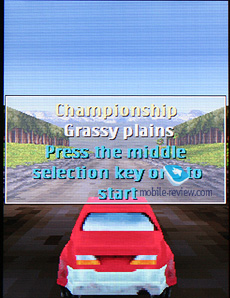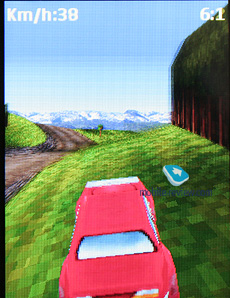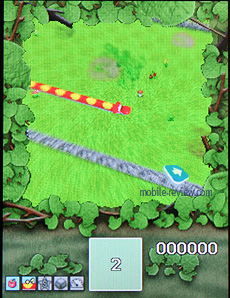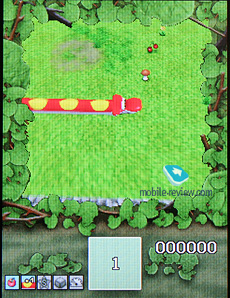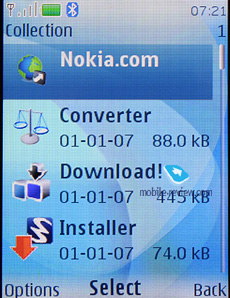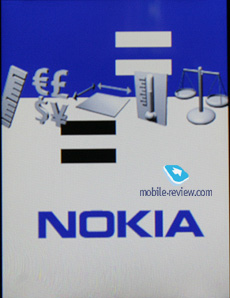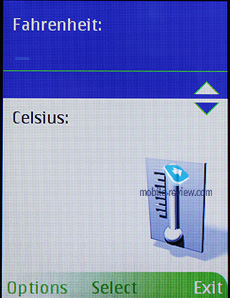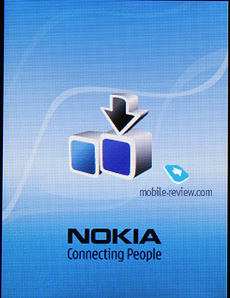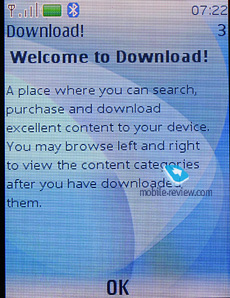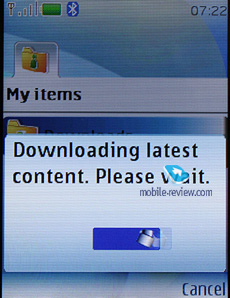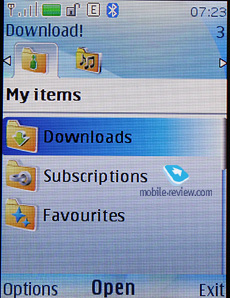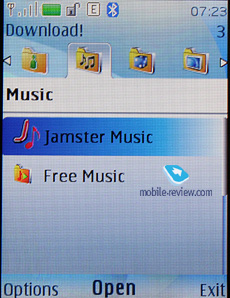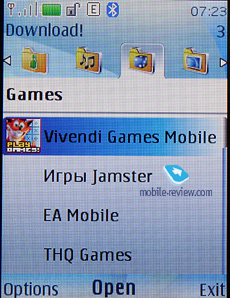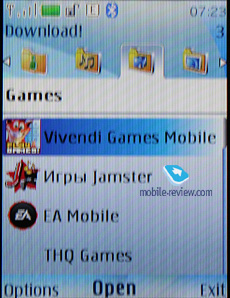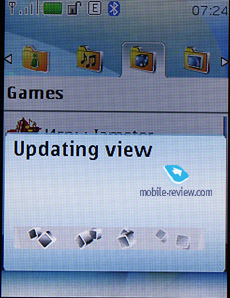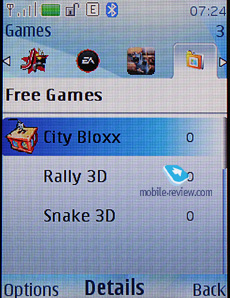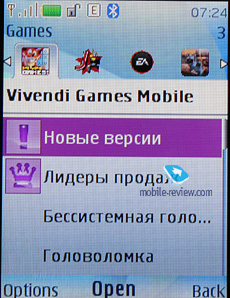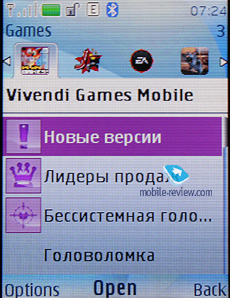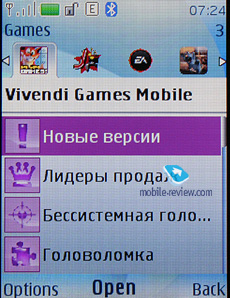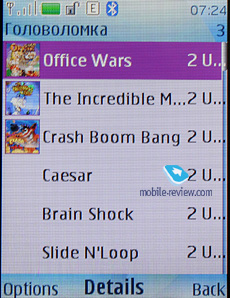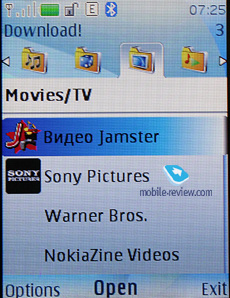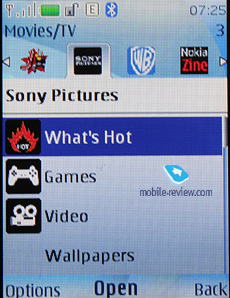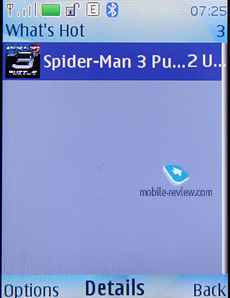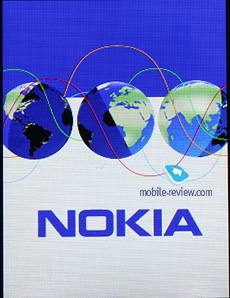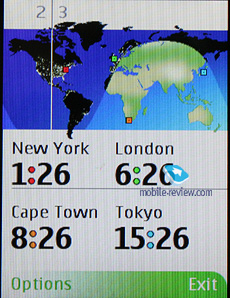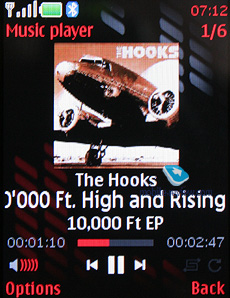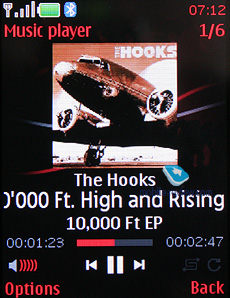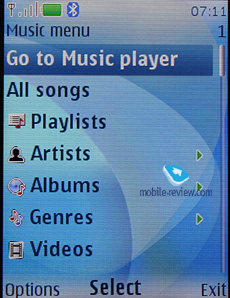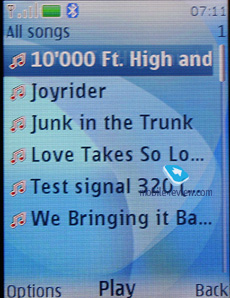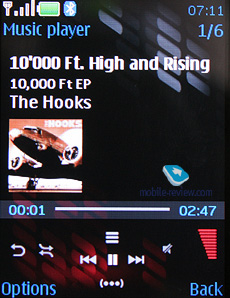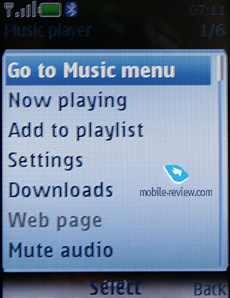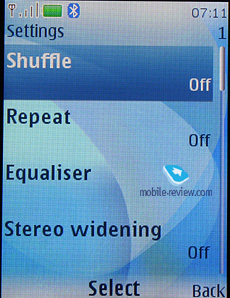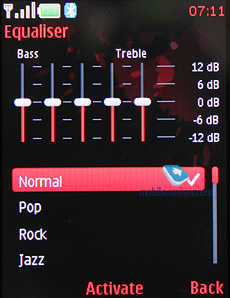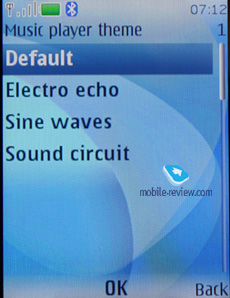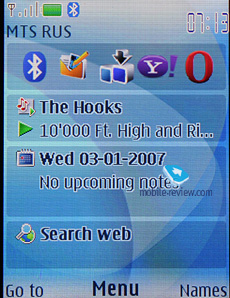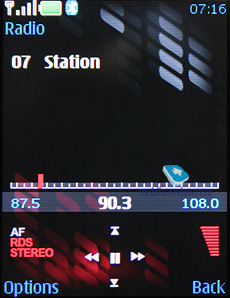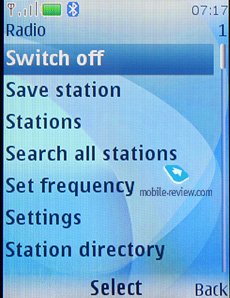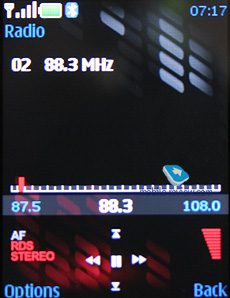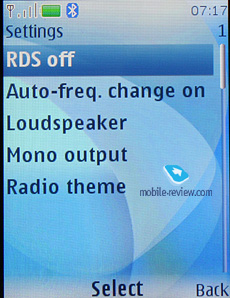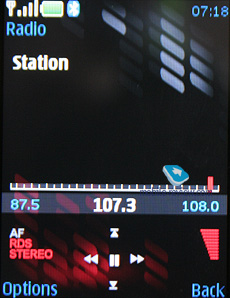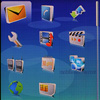|
|
Review of GSM/UMTS-handset Nokia 5610 XpressMusic
Live photos of Nokia 5610
Table of contents:
- Positioning
- Design, size, controls
- Display
- Keypad
- Battery
- Memory, memory cards
- Performance
- USB, Bluetooth
- Camera
- Themes, applications, games
- Music department
- Competition
- Impressions
Sales package:
- Handset
- 900 mAh battery (BP-5M)
- Charger (AC-4)
- User Guide
- Wired stereo-headset (HS-45) with a remote control (AD-56)
- Nokia Micro USB Cable CA-101
- 512 Mb microSD memory card (MU-28) or 1 GB (MU-22) – varies by region
Positioning
At the beginning of our Nokia 5310 review we talked about the positioning of the XpressMusic range and its three “shock troops” - Nokia 5310, Nokia 5610, Nokia 5710. We won’t be going through the same thing over again, so, instead, let’s look at the Nokia 5610 from a somewhat different perspective. In some ways it is a unique phone, as unlike the rest of the pack it has no 3,5 mm audio jack onboard in spite of the fact that over at Nokia they have decided that all music-centric devices should come with one. Surprisingly, the 5610’s design can’t be explained from the standpoint of the XpressMusic line-up consistency – they even managed to cram this jack into the wafer-thin Nokia 5310; and the question is what hampered them in the case of the 5610. In reality, there are no technical difficulties on this front, and there never were; the real reason is that the Nokia 5610 XpressMusic is a copy of the Nokia 6500 Slide.
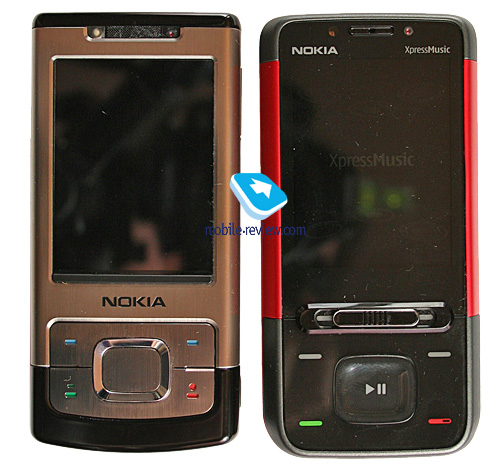
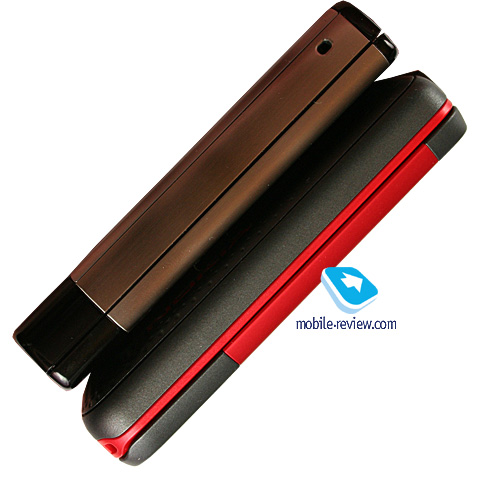
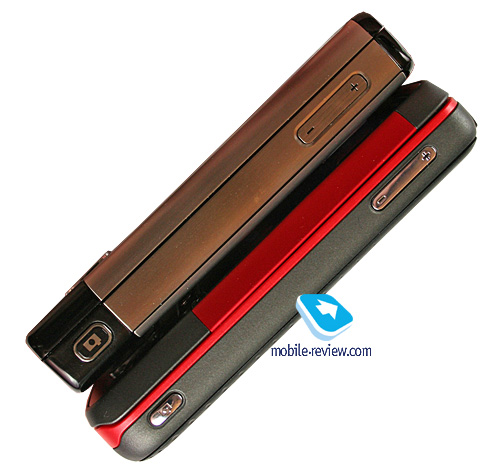
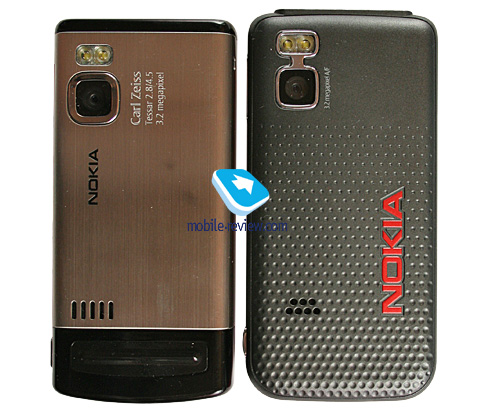
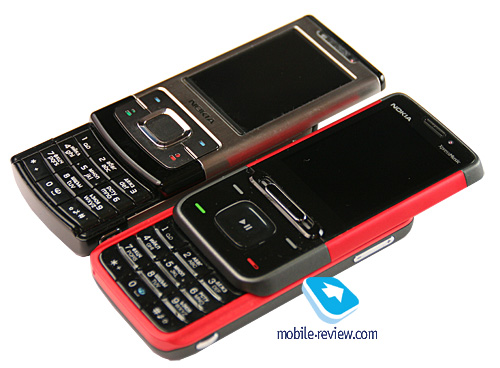
These devices have resembling looks and share all standard controls (although differently styled), expect for the 5610’s slider key. What they really differ in, is sales package – the more fashion-savvy, metal-clad 6500 Slide, comes boxed with a TV Out cable and a smaller memory card (only 256 Mb). In order to set them even further apart, the Nokia 6500 Slide has been armed with a top-of-the-line camera utilizing a Carl Zeiss lens, whereas the music edition of the phone enjoys a less sophisticated unit, and in theory should produce poorer shots.
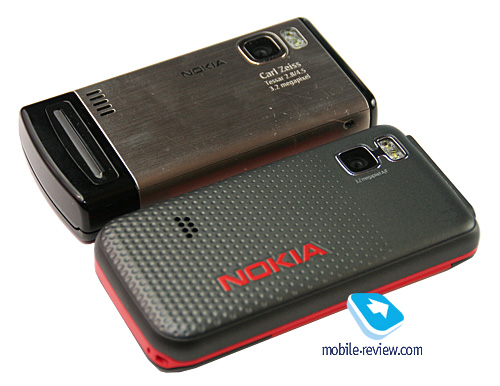
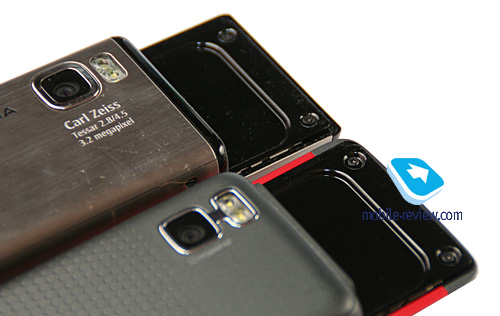

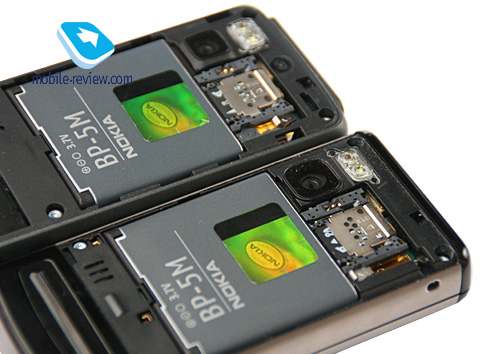
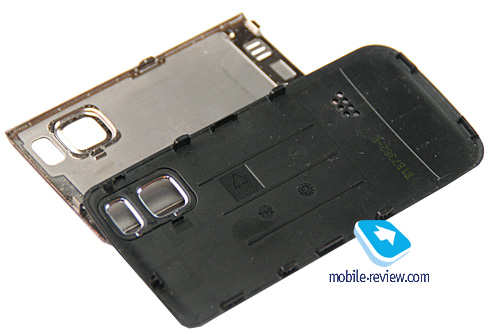
These two models clearly demonstrate Nokia’s strategy on delivering different offerings to specific groups of consumers. Effectively, the maker has rolled out two solutions – one for imaging and the other one for music, which is basically the same approach exercised by other manufacturers.
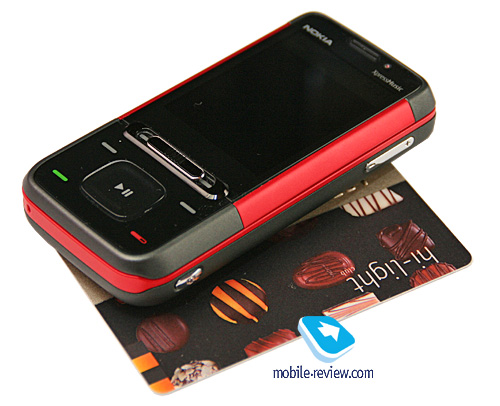
However this makes the Nokia 5610 stand out of the XpressMusic line, as it offers the finest sonic experience among S40 solutions, while on the other hand, other solutions aren’t that far-off (especially if use music as a background or you tend to listen to it in default earphones while in the subway). It lacks the cornerstone advantage of a 3,5mm headphone jack, which negates all its other feats.
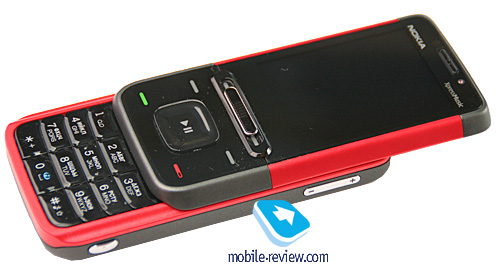
It turns out that compared to the solutions delivered by other manufacturers, for instance, Sony Ericsson, it is pretty much up to date, and as far as sound quality is concerned, even a tad better. And in the context of the XpressMusic line-up, the 5610 is behind its siblings.
Back to the table of contents >>>
Design, size, controls
The handset comes in a choice of two colors – blue and read, which are standard colors of the XpressMusic range. Both trims look fine, although the latter is better suited for women.
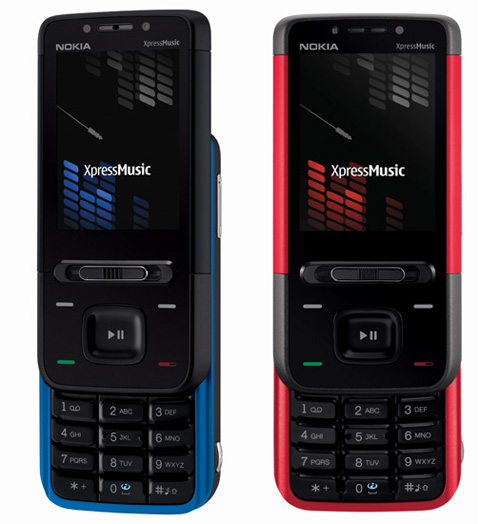
The 5610 measures up at 98.5x48.5x17mm (against the Nokia 6500 Slide’s 96.5x46.5x16.4mm) and weighs 111 grams (which is lighter than the Slide’s 125 grams). It doesn’t seem very big, although delivers a weighty feel while in the hands; the Nokia 5610 is quite palm-friendly and its thickness, albeit it is not the slimmest phone around, doesn’t cause any inconvenience.
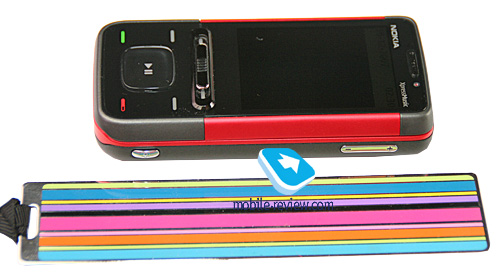
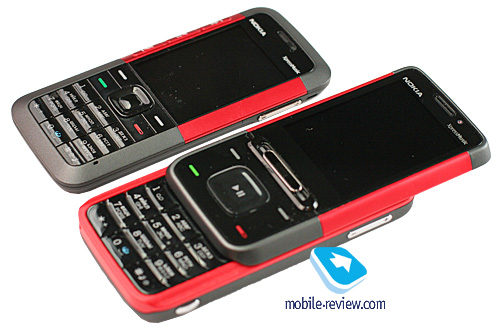
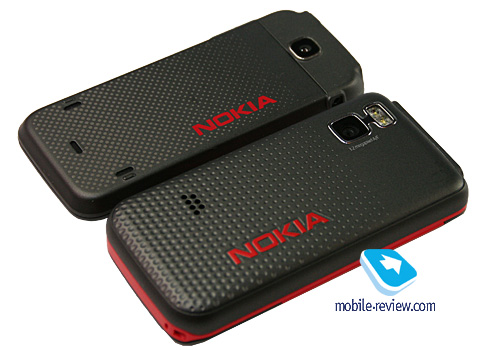
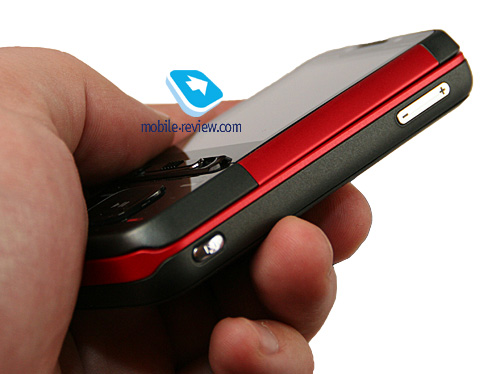
On the rear is the 3,2 Mpix camera lens with auto-focus and Carl Zeiss optics.

There is a sole loudspeaker, placed on the underside, which outputs acceptable sound, whose quality is in line with other Nokia’s offerings.
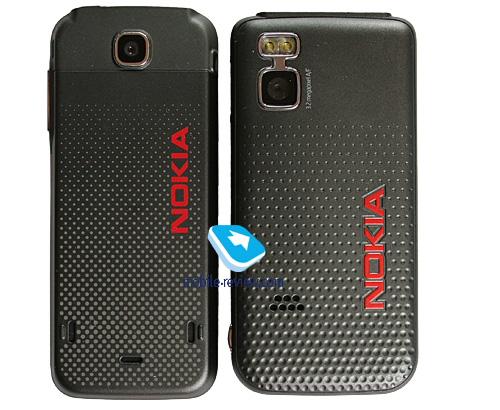
The top end is notable for carrying three sockets – a standard 2,5 mm audio jack, slim charger slot and a microUSB slot. The tiny button standing next to it is the battery cover release latch.
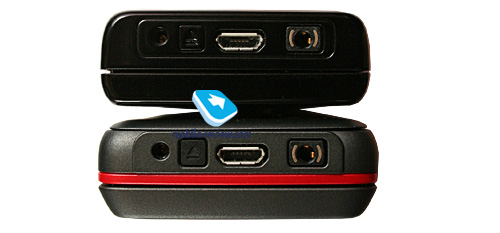
Topping the display is an earpiece, flanked by an ambient light sensor and a CIF-camera for videoconferencing.
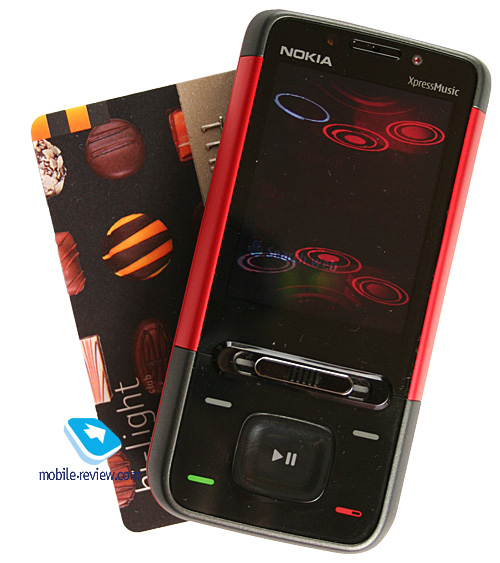
The slider mechanism is pretty decent, the halves slide back and forth effortlessly, a credit here also goes to the spring-loaded mechanism. Your finger will bump straight into the slider key that doubles as a thumb rest. There are no gaps between the handset’s parts and nothing seems to be able to make some in the future.
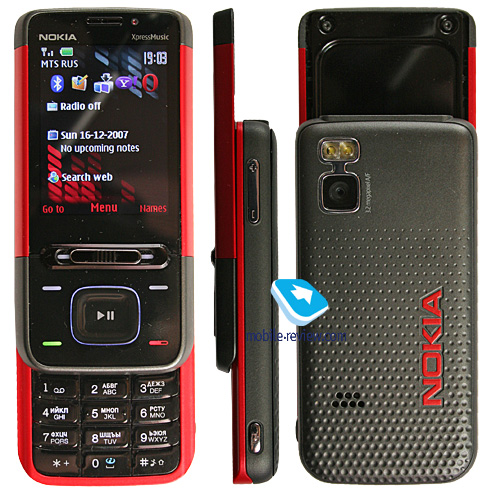
Back to the table of contents >>>
Display
The Nokia 5610 utilizes a QVGA display (TFT, 16 mln colors, which are all bright and vibrant) with a resolution of 240x320 pixels (diagonal of 2,2 inches, 36x48 mm). The manufacturer hasn’t included any type of backlighting adjustment, this allows the phone to save some power, but here is a kind of drawback to it: the model comes with the ambient light sensor that deals with the backlighting level of the display and keypad automatically, and this way, the screen appears to be dim and lackluster against the backdrop of offerings coming with no ambient light sensor onboard (6131, 6300). The same goes for the Nokia 7390, but based on the feedback, it isn’t much of a problem; in fact it isn’t even one. The user is enabled to choose standby screensaver and backlighting mode (on/off) – in the latter case, if the backlighting is turned off, screen will remain redable indoors but only at certain angles. Apart from that you can switch off the display completely, so that it will turn black with no information being shown on it. In view of the screen having a mirror layer, it doesn’t fade in the sun and ensures that all information on it will remain legible.
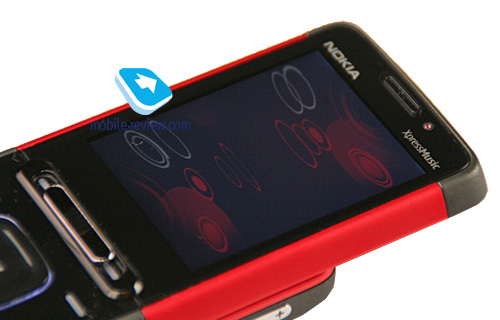
The display accommodates up to 8 text and 3 service lines. The font is pretty big and certainly readable; it can be altered in some modes.
Back to the table of contents >>>
Keypad
The navigation cluster appears a standard touch-sensitive fare. In fact, it is the handset’s only black glossy surface featuring a navigation pad inside. However, this first impression is very delusive – once you start punching the buttons, it becomes clear that these are conventional mechanic keys. This move has a whole lot of positive to it – first, these buttons look slick, yet offer the ergonomics of standard keys.
The four-way navigation key is a breeze to use, but what we really want to highlight here is the Nokia 5610’s slider key design for providing fast access to the handset’s music abilities. Toggling it left while idling will call up the music player, then the handset’s home screen, moving it to the right will launch radio. Pushing it in one direction will cyclically switch all options.
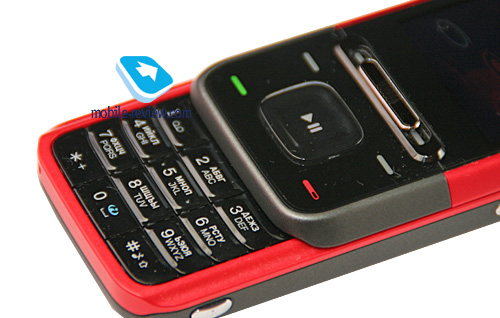
When playing music with the player, using the slider key will not pause the playback, as you will be simply jumping between various screens. All in all, this slider is a quirky control for quick start up of two applications; unfortunately, it is of no use as far as the rest of the handset’s departments are concerned.
Flanking the slider key are two white LEDs that will blink or light up with other effects on incoming calls or missed events. These light effects can be disabled in the phone settings.
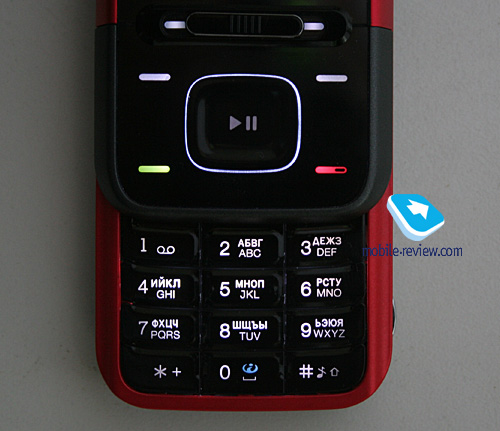
The numeric pad is made of plastic, and while the buttons cramped inside, they are still pretty easy to use and deliver nice tactile feedback. For people with big hands the top row may feel a little fiddly to press – they will keep banging their fingers up against the upper portion of the phone, but that’s not all that irritating.
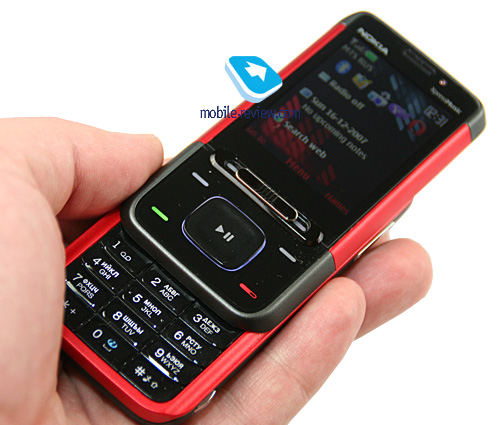
All buttons are lit in bright white; the backlighting level is automatically adjusted by the ambient light sensor.
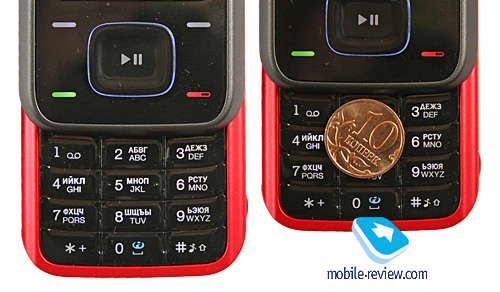
Back to the table of contents >>>
Battery
The Nokia 5610 comes bundled with a 900 mAh Li-Ion battery (the maker’s signature BP-5M cell). The maker rates it for 320 hours of standby and up to 6 hours of talk time.
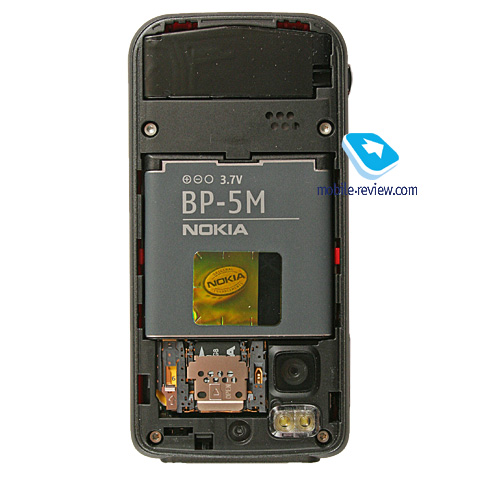
In Moscow the handset lasted around 2 days (1,5 hours of calls, 6 hours of music/radio, up to an hour spent with other feature) – no bells and whistles here, the battery time you get with this phone is par for the course for this type of solutions.
The maker claims the 5610 can play music for 22 hours straight, whereas in reality it offers around 20.5 hours, which is almost twice longer than the Nokia 6500 Slide – all thanks to the DAC33 chip that makes the Nokia 5610 less power-hungry.
It takes the phone less than two hours to charge from empty to full.
Back to the table of contents >>>
Memory, memory cards
The handset ships with around 28 Mb of storage that can be managed by the user. The microSD memory expansion slot is housed under the battery compartment cover, but you can’t swap cards on the fly. The maximum memory card size supported by the device is unlimited – we plugged in our 4 Gb unit and experience absolutely no problems with it.
Back to the table of contents >>>
Performance
The phone is a typical offering for its generation – no bells and whistles here.
Back to the table of contents >>>
USB, Bluetooth
USB. Much like the Nokia 6500 Classic/Slide, the 5610 makes use of a microUSB slot placed on the top end. This socket kicks in when you connect data cable, while the charger and headset have their own respective slots on the casing.
The vendor says that the handset supports USB 2.0, and it does indeed, in USB Mass Storage mode the connection via USB cable puts up medium data transfer speed which makes up about 500-600 Kb/s. This is slower than the Motorola RAZR2 V8, which also comes installed with microUSB-socket.
Upon successful connection you can pick one of the following modes: USB Mass Storage, PC Studio, or modem mode. Also, the handset starts recharging regardless of mode you pick. There is no support for MTP mode, music tracks have to be moved onto the phone manually.
Bluetooth. The handset comes with EDR-enabled Bluetooth 2.0. The following profiles are supported:
- Dial-Up Networking Profile
- Generic Access Profile
- Generic Object Exchange Profile
- Object Push Profile
- Serial Port Profile
- Handsfree Profile
- Headset Profile
- Synchronization Profile
- Basic Image Profile
- File Transfer Profile
- HID (host) Profile
- Stereo Advanced Audio Distribution Profile
- Advanced Audio/Video Remote Conference Profile
- A2DP
The Bluetooth implementation is, as always though, nothing to complain about, we encountered no issues with handling this type of connections.
Back to the table of contents >>>
Camera
We’ve come to the most interesting part of the review, since the Nokia 5610’s camera turns out to be exactly the same as the 6500 Slide’s despite the latter’s Carl Zeiss sweetener. Obviously, the “Carl Zeiss” brand is a marketing trick in many ways that frequently doesn’t do much good in practice. We were curious to compare the shots take by these two cameras, and they looked pretty much the same. Missing Carl Zeiss ad in a music-minded phone is easy to understand – otherwise the Nokia 5610 would have ended up with an unnecessary edge under its belt, dissolving the target audience this way.
Spec-wise, these two camera modules are identical. The following image resolutions are supported:
- 1536õ2048;
- 1200õ1600;
- 960x1280;
- 480x640;
- 240x320;
- 120x160.
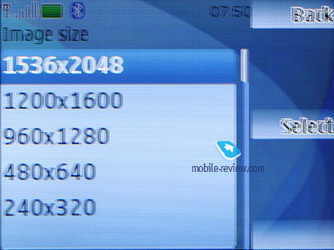
Three JPEG compression settings are supported: basic, normal, high. Speaking of other options, you can adjust the shutter sound (on/off), take advantage of x8 digital zoom, or choose storage place for your shots, modify the white balance settings, ISO level, etc. Overlays may be applied to all taken snaps, so whether it’s worth using them before shooting or not – it is all up to you. The following effects are onboard: Greyscale, Sepia, Negative.
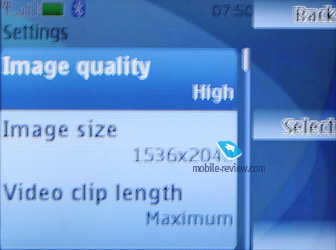
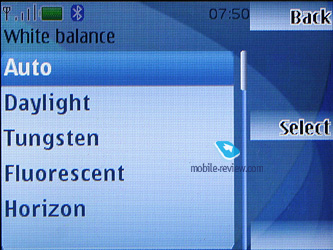
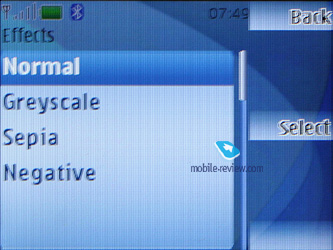

For those keen on the multi-shot mode, there is an option in the 5610 slide that makes the camera take up to 3 shots in a rapid succession, while all settings remain identical to the single-shot mode, including resolution. There is also a 10-second self-timer available.
The camera interface employs the landscape layout, which looks really reminiscent of the Series 40v3 devices, and there is nothing special about it – shooting with the 5610 is pretty comfortable, however the ergonomics of this process are still a few steps behind Sony Ericsson’s solutions, as well as Nokia’s own multimedia smartphones.

| Nokia 5610 |
Nokia 6500 Slide |
 |
 |
| (+) maximize, 2048õ1536, JPEG |
(+) maximize, 2048õ1536, JPEG |
 |
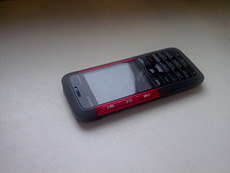 |
| (+) maximize, 2048õ1536, JPEG |
(+) maximize, 2048õ1536, JPEG |
 |
 |
| (+) maximize, 2048õ1536, JPEG |
(+) maximize, 2048õ1536, JPEG |
 |
 |
| (+) maximize, 2048õ1536, JPEG |
(+) maximize, 2048õ1536, JPEG |
 |
 |
| (+) maximize, 2048õ1536, JPEG |
(+) maximize, 2048õ1536, JPEG |
 |
 |
| (+) maximize, 2048õ1536, JPEG |
(+) maximize, 2048õ1536, JPEG |
 |
 |
| (+) maximize, 2048õ1536, JPEG |
(+) maximize, 2048õ1536, JPEG |
 |
 |
| (+) maximize, 2048õ1536, JPEG |
(+) maximize, 2048õ1536, JPEG |
 |
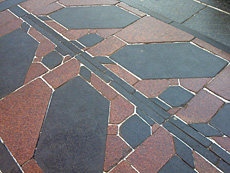 |
| (+) maximize, 2048õ1536, JPEG |
(+) maximize, 2048õ1536, JPEG |
 |
 |
| (+) maximize, 2048õ1536, JPEG |
(+) maximize, 2048õ1536, JPEG |
 |
 |
| (+) maximize, 2048õ1536, JPEG |
(+) maximize, 2048õ1536, JPEG |
 |
 |
| (+) maximize, 2048õ1536, JPEG |
(+) maximize, 2048õ1536, JPEG |
 |
 |
| (+) maximize, 2048õ1536, JPEG |
(+) maximize, 2048õ1536, JPEG |
 |
 |
| (+) maximize, 2048õ1536, JPEG |
(+) maximize, 2048õ1536, JPEG |
 |
 |
| (+) maximize, 2048õ1536, JPEG |
(+) maximize, 2048õ1536, JPEG |
 |
 |
| (+) maximize, 2048õ1536, JPEG |
(+) maximize, 2048õ1536, JPEG |
 |
 |
| (+) maximize, 2048õ1536, JPEG |
(+) maximize, 2048õ1536, JPEG |
 |
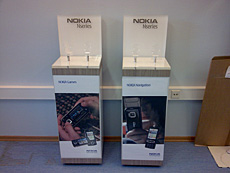 |
| (+) maximize, 2048õ1536, JPEG |
(+) maximize, 2048õ1536, JPEG |
 |
 |
| (+) maximize, 2048õ1536, JPEG |
(+) maximize, 2048õ1536, JPEG |
 |
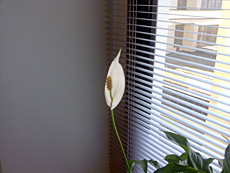 |
| (+) maximize, 2048õ1536, JPEG |
(+) maximize, 2048õ1536, JPEG |
 |
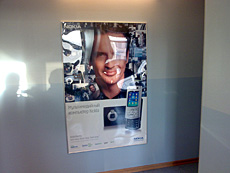 |
| (+) maximize, 2048õ1536, JPEG |
(+) maximize, 2048õ1536, JPEG |
Video. The handset allows recording video in 3GP format, available resolutions – 128x96 pixels, or 176x144, 352x288, 640x480 pixels. There are there quality settings available. Video clip length is limited only the amount of free memory (internal storage or memory card). Also you can go for effects, which are the same as those for still images. Video looks quite acceptable only when you watch it on the handset – when viewing it on PC, you will inevitably stumble upon various artifacts, but it’s still bearable, which is another good thing about the 5610. Comparing the 5610’s video clips taken in the 352x288-pixel resolution with videos captured by Samsung’s phones (same resolution and quality), the 5610 seems to do a more decent job thanks to more natural colors.
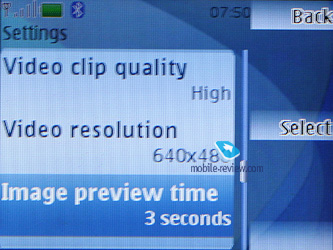
Back to the table of contents >>>
Themes, applications, games
The handset packs in a couple of themes keyed to its music-heavy nature, plus they match the 5610’s trims (i.e. red themes for the red color scheme, blue – for its blue edition). Unfortunately, the default themes don’t modify the menu or icons. The much-hyped wallpapers that live their own life and shape-change during day and night, when the battery is low etc, are not among the handset’s preinstalled features, although you can grab them from any other phone – these wallpapers are supported by all solutions running on this OS edition (being mere flash clips).
Also onboard are some games: City Bloxx, Music Guess, Rally 3D, Snake III.
The default suite of applications includes Converter, Nokia Sensor, World Time, Opera Mini, Download catalogue, Yahoo! Go, Search. Some markets may also see extra apps and games. Java applications of any size can be uploaded over the air or directly into the handset’s memory.
Back to the table of contents >>>
Music department
Discounting the missing 3,5mm audio jack on the casing (which is still available on what they call “remote”, while in fact it is an ordinary clothing clip with a lone Call/Pause button on it), the 5610 is very similar to the Nokia 5310 – it also employs a dedicated audio chip, the AIC33, and outputs decent sound, which is loud enough at that.
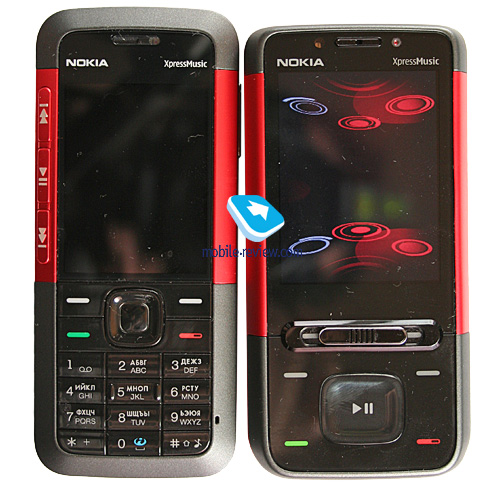
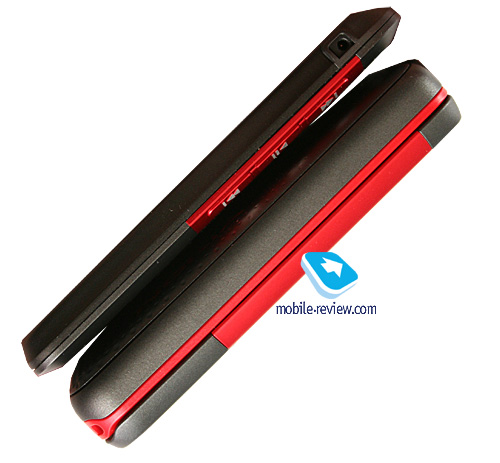
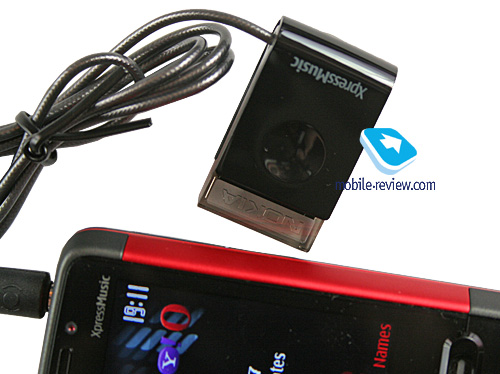
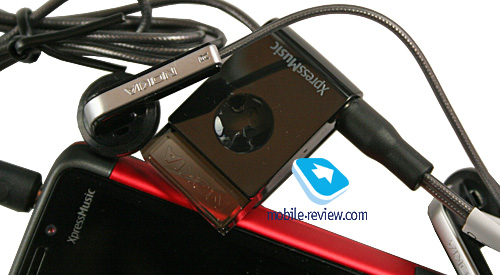
The music player, just like all other solutions powered by the S40 5th edition enjoy themes, although there are all pretty lackluster, as they can’t change the player’s looks, even though the 5610’s non-music sibling, the Nokia 6500 Slide could do that. As I see it, this is an obvious misstep on Nokia’s part – what’s the point of including them at all in this case, plus you can’t upload new themes? Moving on, the user is free to play around with themes for radio, but they are exactly the same – nothing to write home about.
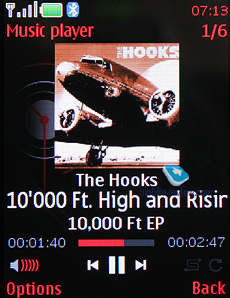
The lack of dedicated music buttons is not an letdown, since all they do is add some extra convenience to the whole process. Unfortunately, the headphones you take out of the box should sit on the top of your to-ditch list, provided that you prefer having great sonic experiences.
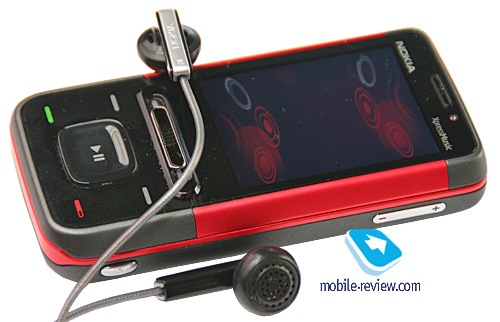
The 5610 is a potent performer as far as music goes; we also put it through its paces in our RMAA tests.
Alexander Dembovsky’s take:
The handset performed as a solid mid-tier music phone in our routine tests – effectively, the Nokia 5610’s membership in the company's series of music phones has had no effect on its performance; we used to see similar numbers with non-music heavy offerings too.
Despite having no real 3,5mm jack, hence the necessity to deal with adapters, the phone’s sound quality is pretty good, although as a rule any adapter distorts signal and puts in some unwanted noises. While you are probably not going to hear that, our RMAA tests immediately reveal them. This makes the performance of the Nokia 5610 all the more admirable, though, since even with an adapter plugged in, it managed to output clear, and more importantly, strong signal.
The 5610’s frequency response graph is quite even, although there are some glitches as far as the highs are concerned. Its noise level is acceptable as well. What is more, the handset’s output signal strength is pretty much in line with audio players, so there is really no reason to worry about it not being able to deal with your earbuds or light clip-on headphones.
General performance
| Frequency response (from 40 Hz to 15 kHz), dB: |
+0.17, -1.39 | Average |
| Noise level, dB (A): |
-88.0 | Good |
| Dynamic range, dB (A): |
87.1 | Good |
| THD, %: |
0.012 | Good |
| IMD, %: |
0.727 | Bad |
| Stereo crosstalk, dB: |
-73.4 | Good |
| Intermodulation at 10 kHz, %: |
0.138 | Average |
General performance: Average
Frequency response

Noise level

The 5610 can play music for 20.5 hours straight, which is a pretty good result by contemporary standards. While in the speakerphone mode it utilizes only one loudspeaker, meaning there is no stereo, what I doubt that it’s something you will need to bad. This phone is not a juke box, and its sole speaker sounds as clear as the stereo-speakers found on the Nokia 5310.
Spec-wise, the 5610’s music player is no different from the default S40 5th edition’s application – learn more about it in our dedicated piece on this platform’s functionality.
FM-radio. The Nokia 5610’s radio supports RDS and can work in the background mode. The thing that really lets it down is that when using auto-tuning, it picks up 7-8 stations at best, even though there are many more stations scattered across the frequency. All in all, the radio here is quite good, plus there is Visual Radio, however utilizing it outside 3G networks doesn’t seem to be the best way to go – pictures and other data take a whole lot of traffic to load. As far as radio goes, the Nokia 5610 easily holds its own compared to solutions from other makers.
Back to the table of contents >>>
Competition
So happens, that Nokia’s music phones have always been design to struggle against the arch-rival – Sony Ericsson’s Walkman range. In this sense the Nokia 5610 is somewhat similar to flagship that reigned in the previous season, the Sony Ericsson W850i. However, much time has passed since then and when the Nokia 5610 debuted, its Sony Ericsson-branded vis-a-vis had been long gone.
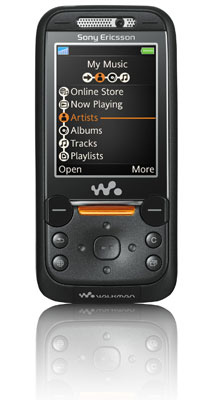
It is always interesting to witness the patterns formed by release dates of Nokia’s and Sony Ericsson’s offerings – they are dancing around each other, as if afraid to come closer, so they end up rolling out their solutions one after another without ever confronting in a direct fashion. Had the Sony Ericsson W760i been released right now, it would have posed a direct threat to the Nokia 5610, as their specs and sales packages are very similar, but, alas, it is slotted for May.
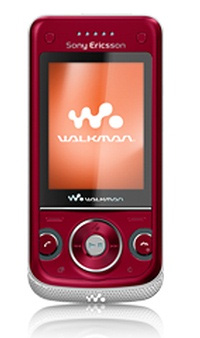
That’s why the Nokia 5610 faces no direct competition from Sony Ericsson’s camp – the Sony Ericsson W580i is positioned lower, while the W910i comes from a higher tier. Looking for more music-minded sliders to rival 5610, you’ll find only the Samsung G600 available in this price bracket. While the maker doesn’t present it as a music playing phone, in terms of sound quality it is comparable with the Nokia 5610; but as for the rest, it is the latter’s exact opposite, and it is really hard to tell who might hold the upper hand. Speaking in favor of the G600 is its 5 Mpix camera, but it sports a less sophisticated menu, lacks many extra options. That’s why it is more of an indirect rival. The music-savvy Samsung F330 goes for less money and offers less punch as well. Another indirect alternative is the Samsung i450, but it employs a different philosophy, plus boasts a bigger casing, but the truth is, delivers a slightly better sonic experience.
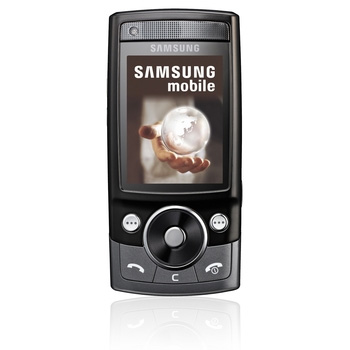
As far as indirect competition is concerned, it is especially strong within Nokia’s own range – for instance, the now withdrawing Nokia E65 is an extremely enticing offering at this price point. While its music department doesn’t have all the merits of the 5610, it is a smartphone and delivers every last thing you expect from this type of handset.
Those who are in the market after top-notch music quality and happen to be loyal to Nokia at that, should consider the Nokia N81 as a possible way to go, in case they are bent on sliders – under the N81’s hood are comparable sound quality, flexible player settings, a bevy of extra options and a heftier price tag (pretty much the same as the Nokia 6500 Slide).
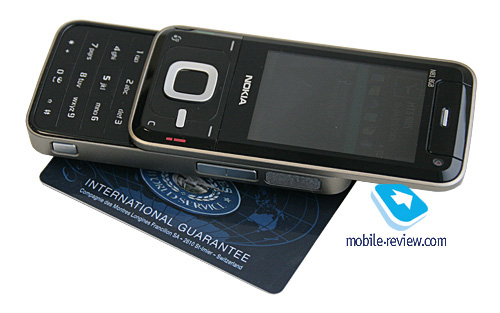
Back to the table of contents >>>
Impressions
The volume of 64-chord ring tones is quite high, so you are very unlikely to miss a call, but, since there is only one loudspeaker, mounted on the rear at that, it was not a rare occasion when we had the 5610 in jeans and didn’t hear it ring. In terms of reception quality, the phone is flawless. The vibro alert is middling strength-wise, but you will feel the phone’s vibration while it is in your pocket.
In most regions the Nokia 5610 retails for 300 Euro; as far as Russia is concerned, 500 USD will buy you one here. The Nokia 6500 Slide’s price tag is 70 Euro heftier, which is the tradeoff for being more fashion-savvy and metal accents in the casing, while it fall short of the 5610 on the music front since it lacks a dedicated sound chip. But at the same time, camera-wise these two solutions are pretty much in one boat, so it turns out that the junior offering proposes a better price/quality ratio. So this isn’t an easy dilemma by any means, but if you are after music, then the choice is pretty much clear-cut.
Lacking any direct competition the Nokia 5610 seems to be a potent phone, on top of that, there aren’t many alternatives as far as sliders of this type are concerned. All the above handsets rival it indirectly, leaving much room on the market for the 5610 to conquer.
SAR value for the Nokia 5610 – 1.14 W/kg.
Related links:
Back to the table of contents >>>
Eldar Murtazin (eldar@mobile-review.com)
Translated by Oleg Kononosov (oleg.kononosov@mobile-review.com)
Published — 07 February 2008
Have something to add?! Write us... eldar@mobile-review.com
|
News:
[ 31-07 16:21 ]Sir Jony Ive: Apple Isn't In It For The Money
[ 31-07 13:34 ]Video: Nokia Designer Interviews
[ 31-07 13:10 ]RIM To Layoff 3,000 More Employees
[ 30-07 20:59 ]Video: iPhone 5 Housing Shown Off
[ 30-07 19:12 ]Android Fortunes Decline In U.S.
[ 25-07 16:18 ]Why Apple Is Suing Samsung?
[ 25-07 15:53 ]A Few Choice Quotes About Apple ... By Samsung
[ 23-07 20:25 ]Russian iOS Hacker Calls It A Day
[ 23-07 17:40 ]Video: It's Still Not Out, But Galaxy Note 10.1 Gets An Ad
[ 19-07 19:10 ]Another Loss For Nokia: $1 Billion Down In Q2
[ 19-07 17:22 ]British Judge Orders Apple To Run Ads Saying Samsung Did Not Copy Them
[ 19-07 16:57 ]iPhone 5 To Feature Nano-SIM Cards
[ 18-07 14:20 ]What The iPad Could Have Looked Like ...
[ 18-07 13:25 ]App Store Hack Is Still Going Strong Despite Apple's Best Efforts
[ 13-07 12:34 ]Infographic: The (Hypothetical) Sale Of RIM
[ 13-07 11:10 ]Video: iPhone Hacker Makes In-App Purchases Free
[ 12-07 19:50 ]iPhone 5 Images Leak Again
[ 12-07 17:51 ]Android Takes 50%+ Of U.S. And Europe
[ 11-07 16:02 ]Apple Involved In 60% Of Patent Suits
[ 11-07 13:14 ]Video: Kindle Fire Gets A Jelly Bean
Subscribe
|



